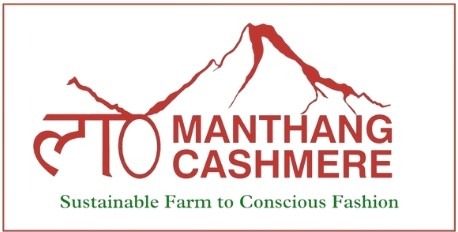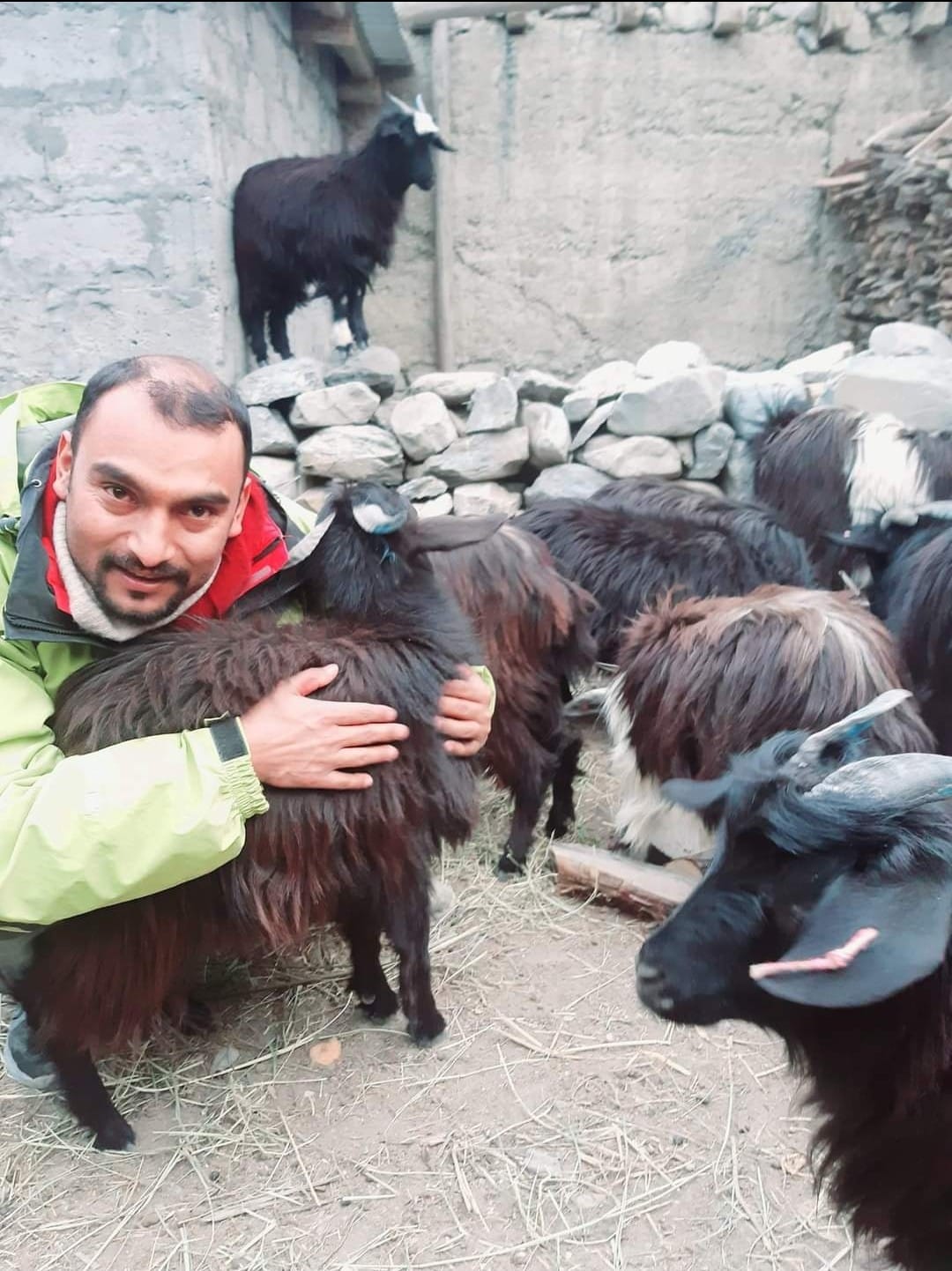Lomanthang Chyangra Cashmere Farm to Fashion Process :
Lomanthang Chyangra Cashmere manufacturing is a meticulous and skilled process that involves several steps to transform raw chyangra cashmere wool into luxurious textiles such as scarves, shawls, blankets, and clothing. Here’s an overview of the typical cashmere manufacturing process:
1. Raw Material Preparation
• Combing: Lomanthang Chyangra Cashmere wool is obtained by combing the hairs of Himalayan cashmere goats of Nepal. Each raw under coat hair strand is combed very carefully and without harsh treatment.
• Sorting and Cleaning: The raw cashmere fibers are sorted to remove any debris, dirt or coarse hairs. This step is crucial to ensure that only the finest and softest fibers are used for weaving or knitting. It also includes sorting of different natural brown shades of cashmere.
2. Carding and Spinning:
• Carding: The sorted lomanthang chyangra cashmere fibers are carded to align them into a uniform web or sliver, removing impurities and preparing the fibers for spinning.
• Spinning: Our cashmere yarn is hand-spun using a spinning wheel or spindle. This process twists the fibers together to create yarn of varying thicknesses, depending on the desired texture of the final product.
3. Dyeing (if required)
• Natural / Plant / Botanical / Vegetables: Depending on the design and color preferences, the yarn may be dyed using botanical dyes. Natural dyes often include plant extracts and minerals which are bio-degradable.
4. Weaving & Knitting
4.1 Weaving
• Warping: The yarn is wound onto a loom in a process known as warping. This sets the lengthwise threads (warp threads) of the fabric.
• Weaving: The weaving process involves interlacing warp threads with weft threads using a handloom to create patterns and textures.
4.2 . Knitting:-
• Hand Knit:- This is the basic knitting method done by hand along with the long needles looping the thread into the desired products.
• Hand Flat Knit:- The term hand flat is used to describe a type of knitting machine that is hand operated and contains a flat bed of needles.
5. Finishing
• Washing: Once the weaving is complete, the fabric undergoes washing to remove any residual dyes or sizing agents.
• Pressing: The washed fabric is steam-pressed to smoothen and set the weave.
• Fringing or Edging: Depending on the design, the edges of the fabric may be finished with fringes, tassels, or hemming.
6. Quality Control
• Throughout the entire process, quality control measures ensure that the finished cashmere products meet the desired standards for softness, strength, and color vibrancy.
7. Packaging and Distribution
• Once finished and inspected, the cashmere products are packaged for distribution to local markets or export to international buyers.
Traditional Classical Methods
• While traditional methods involve hand-spinning and hand-weaving, modern cashmere weaving may also utilize mechanized processes to increase efficiency while maintaining quality.
Cashmere weaving is not only a skilled craft but also a cultural tradition in regions like Lo Manthang and Kirtipur ( Small Village of Kathmandu Valley ) in Nepal, where the techniques and designs have been passed down through generations. It represents a blend of artistry, craftsmanship, and sustainable production practices that contribute to the allure and value of cashmere textiles world wide.
Hand Flat Knit Method :
Knitting cashmere on a flat knitting machine involves a different process compared to hand knitting. Flat knitting machines are used for producing knitted fabrics in a flat, rectangular shape, suitable for items like scarves, blankets, panels for garments, and more. Here are the basic steps involved in knitting cashmere on a flat knitting machine:
1. Yarn and Machine Setup
• Yarn Selection: Our skilled worker first chooses cashmere count (thickness) of yarn suitable for no. of gauge for hand flat machine knitting. Lo Manthang Cashmere yarns come in various weights ensuring the yarn is compatible with a particular knitting machine.
• Machine Setup: Our craftsperson then sets up the flat knitting machine according to the gauge (stitch density) required for the particular design. This includes selecting appropriate needles and adjusting tension settings for the cashmere yarn.
2. Pattern Selection
• Pattern Setup: Depending on the machine’s capabilities, our artisan manually set up the needle arrangement for the desired stitch pattern.
• Stitch Type: Flat knitting machines can produce various stitches, including plain knit, ribbing, cables, lace patterns, and more. So we stitch our products as per our requirements with different stitch types.
3. Casting On
• Machine Casting On: We usually load the first row of needles with cashmere yarn to cast on the initial stitches. This creates the foundation row for knitting.
4. Knitting Process
• Machine Operation: We operate the knitting machine to knit rows of stitches according to the desired pattern. The hand-flat knitting machine automatically knits each row across all needles, forming the fabric.
• Monitoring: We make sure to monitor the knitting process to ensure smooth operation and adjust tension or settings as needed to maintain consistent stitch quality.
5. Shaping and Finishing
• Shaping: In the hand-flat knit machine, the knitting operator shapes the fabric as required by increasing or decreasing stitches and also knitting the raglan.
6. Finishing Touches
• Linking or Hemming: Now our linking or hemming artisan links the yarn and secures the loose end. Depending on the design, additional finishing steps such as blocking or linking pieces together may be required.
• Quality Control: Our QC checks the finished piece for any defects or irregularities, ensuring it meets quality standards.
Tips for Machine Knitting Cashmere:
• Yarn Tension: Cashmere is delicate, so adjust the machine’s tension carefully to prevent stretching or breakage of the yarn.
• Practice: Machine knitting requires practice to master, especially when working with luxury fibers like cashmere. Start with simpler projects before tackling more complex patterns.
• Maintenance: Regularly maintain your knitting machine to ensure smooth operation and longevity.

